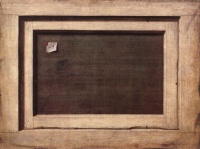User:Jahsonic/The history of the trompe-l'œil is illustrated by one legend and a couple of paintings
From The Art and Popular Culture Encyclopedia
|
Related e |
|
Featured: |
The history of the trompe-l'œil is illustrated by one legend and a couple of paintings.
Our history starts with a legend, the story is that of an art competition between Ancient Greek painters Zeuxis and his contemporary Parrhasius, a contest which I've named "The curtains are the painting" for this occasion, rather clumsily illustrated here[1].
The first trompe-l'œil painting that changed the world while no one was watching was Reverse Side Of a Painting[2] by 17th century Antwerp painter Cornelis Norbertus Gysbrechts.
Charles Willson Peale enters the scene with his self-portrait The Artist in His Museum[3] which alludes to the curtains of Parrhasius. His son, Raphaelle Peale would hide a beautiful woman behind a napkin, which serves again as a curtain, in his painting Venus Rising from the Sea — A Deception[4].
The final scene takes place in an art studio in Belgium, where René Magritte painted two tableaux[5][6], each bearing the name The Human Condition.


